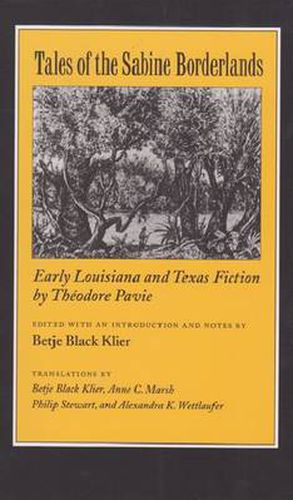Readings Newsletter
Become a Readings Member to make your shopping experience even easier.
Sign in or sign up for free!
You’re not far away from qualifying for FREE standard shipping within Australia
You’ve qualified for FREE standard shipping within Australia
The cart is loading…






In February, 1830, eighteenyearold Theodore Pavie traveled west on the Camino Real from Natchitoches, in the new state of Louisiana, to Nacogdoches, Texas, which remained under Mexican rule. Events of his trip inspired him to write stories rich in details of the LouisianaTexas border region after he returned to France. Le Negre depicts the internal dynamics of a Louisiana slave community in an elemental tale of good versus evil. Pavie contrasts the nobility of the tragic hero, once a tribal chief in Africa, with the inhumanity of his white overseer. Le Lazo is one of the first pieces of Texas or Western literature. It is an enigmatic blend of reportage and imagination reflecting the effects of the Fredonian Rebellion of 1827, the Spanish invasion of Mexico in 1829, and the passage of the Law of 6 April 1830, which triggered the next phase of Anglo rebellion against Mexican authorities in Texas. The Mexican protagonist Antonio enters into conflict with the Creole commander of the presidio at Nacogdoches, Col. Jose de las Piedras. Both men pursue rosaryclutching Clara, who represents the vessel of the new era to come. Pavie brings to life a diverse and rapidly evolving society between Nacogdoches and Natchitoches. The fear inspired by Texas’ unstable political situation in the 1820s drives the action of The Bearskin, which takes place in Louisiana where shock waves are felt in the planter society. El Cachupin tells of the fullblooded Spaniard, Pepo, and his Creole wife, Jacinta, who had been successfully established in Texas, only to be chased across the Sabine by increasing political hostilities in Mexico. East of the river, a lonely planter (probably a remnant of the pirate Lafitte’s band) and his concubine take them in and alter their fate. After Pavie’s death in 1896, his works slipped into quiet oblivion until Betje Klier discovered his travel journal and letters in the late 1980s. Both Pavie and his modern biographereditor Klier work at the intersection of history and literature. Borderlands and Western historians, anthropologists, literati, and travelers will be interested in exploring these treasures of historical detail and early examples of American ethnographic fiction.
$9.00 standard shipping within Australia
FREE standard shipping within Australia for orders over $100.00
Express & International shipping calculated at checkout
In February, 1830, eighteenyearold Theodore Pavie traveled west on the Camino Real from Natchitoches, in the new state of Louisiana, to Nacogdoches, Texas, which remained under Mexican rule. Events of his trip inspired him to write stories rich in details of the LouisianaTexas border region after he returned to France. Le Negre depicts the internal dynamics of a Louisiana slave community in an elemental tale of good versus evil. Pavie contrasts the nobility of the tragic hero, once a tribal chief in Africa, with the inhumanity of his white overseer. Le Lazo is one of the first pieces of Texas or Western literature. It is an enigmatic blend of reportage and imagination reflecting the effects of the Fredonian Rebellion of 1827, the Spanish invasion of Mexico in 1829, and the passage of the Law of 6 April 1830, which triggered the next phase of Anglo rebellion against Mexican authorities in Texas. The Mexican protagonist Antonio enters into conflict with the Creole commander of the presidio at Nacogdoches, Col. Jose de las Piedras. Both men pursue rosaryclutching Clara, who represents the vessel of the new era to come. Pavie brings to life a diverse and rapidly evolving society between Nacogdoches and Natchitoches. The fear inspired by Texas’ unstable political situation in the 1820s drives the action of The Bearskin, which takes place in Louisiana where shock waves are felt in the planter society. El Cachupin tells of the fullblooded Spaniard, Pepo, and his Creole wife, Jacinta, who had been successfully established in Texas, only to be chased across the Sabine by increasing political hostilities in Mexico. East of the river, a lonely planter (probably a remnant of the pirate Lafitte’s band) and his concubine take them in and alter their fate. After Pavie’s death in 1896, his works slipped into quiet oblivion until Betje Klier discovered his travel journal and letters in the late 1980s. Both Pavie and his modern biographereditor Klier work at the intersection of history and literature. Borderlands and Western historians, anthropologists, literati, and travelers will be interested in exploring these treasures of historical detail and early examples of American ethnographic fiction.